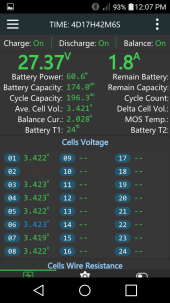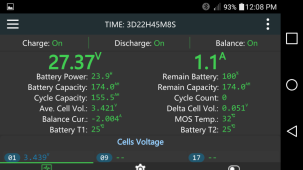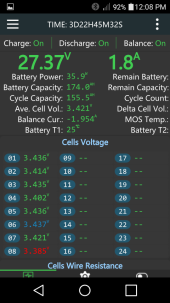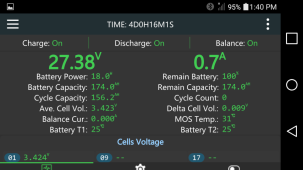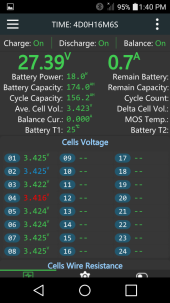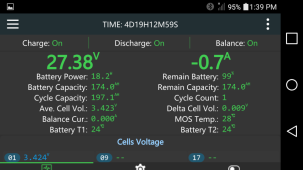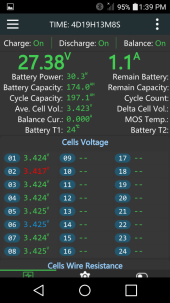Steve_S
Offgrid Cabineer, N.E. Ontario, Canada
I really don't get the hangup on the Paralleled Battery Packs using JK or any other respectable BMS. As long as the system is properly "built" with equal length wire, each pack is independently fused with the "correct" fuse there really should be no issues, many of us are doing it.
Batteries in Series has always been a challenge and moreso depending on the chemistry involved and that has lead to a lot of "bafflegab" and confusion. With the Battery Tech we are using here which is mostly LFP, there is little need to place batteries in Series unless people are purchasing Prebuilts and even BattleBorn has made this clear as to limitations and they actually support limited Series Batteries. Below is an extract on Paralled Batteries.
There IS a GOTCHA with Parallel Packs in a Bank and this is what I believe is the underlying troublespot here.
Example: If a bank of 3 packs is running along and is at 75% and 1 pack disconnects for whatever reason, the other two will continue and take the extra charge/discharge without consideration. The "down" pack will remain at 75% until the problem is resolved (unless the failure is draining it). Once corrected and being put back "online" the SOC Differential can create havoc within the bank resulting either in a Surge out if the other 2 packs are at a lower SOC or a large surge inbound from the 2 packs because they are at a higher SOC. In Both of those instances, the Instant Rush can exceed the individual BMS capabilities resulting in Damage and even releasing the Magic Smoke.
This is one of the major downsides of using FET Based BMS', as Relay-based ones just drop the Relay/SSR instantly when required, disconnecting the pack and no FETS get smoked. In that instance the Relay/SSR Capacity is the limiting factor and which can be 200-1000A or more and why they are used in EV's that push/pull a lot of juice.
This is also another reason we "geezers here" also used to remind anyone building a Paralleled Bank to build it so that "any pack" within the bank can act as the "Last Man Standing", meaning that it could handle the Max potential Charge/Discharge of the system that it is supporting. This is not terribly difficult with a small system, but larger systems are not easy to do and sometimes impractical.
I hope this helps to clarify a few items.
Batteries in Series has always been a challenge and moreso depending on the chemistry involved and that has lead to a lot of "bafflegab" and confusion. With the Battery Tech we are using here which is mostly LFP, there is little need to place batteries in Series unless people are purchasing Prebuilts and even BattleBorn has made this clear as to limitations and they actually support limited Series Batteries. Below is an extract on Paralled Batteries.
Advantages
The main advantage of wiring batteries in parallel is that you increase the available runtime of your system while maintaining the voltage. Since the amp-hour capacities are additive, two batteries in parallel double your runtime, three batteries triple it, and so on.
Another advantage to wiring batteries in parallel is that if one of your batteries dies or has an issue, the remaining batteries in the system can still provide power.
Disadvantages
The main drawback to wiring batteries in parallel vs. series is that the system voltage will be lower, resulting in a higher current draw. Higher current means thicker cables and more voltage drop. Larger power appliances and generation are harder to operate and less efficient when operating at lower voltages.
How Many Batteries Can You Wire In Series?
The limit on how many batteries you can wire in series typically depends on the battery and manufacturer. For example, Battle Born allows up to four of their lithium batteries to be wired in series to create a 48-volt system. Always check with your battery manufacturer to ensure you do not exceed their recommended limit of batteries in series.
note this, if the internal BMS' exceed their max voltage the Magic Smoke appears
How Many Batteries Can You Wire In Parallel?
There is no limit to how many batteries you can wire in parallel. The more batteries you add in a parallel circuit, the more capacity and longer runtime you will have available. Keep in mind that the more batteries you have in parallel, the longer it will take to charge the system.
SOURCE: https://battlebornbatteries.com/batteries-in-series-vs-parallel/
There IS a GOTCHA with Parallel Packs in a Bank and this is what I believe is the underlying troublespot here.
Example: If a bank of 3 packs is running along and is at 75% and 1 pack disconnects for whatever reason, the other two will continue and take the extra charge/discharge without consideration. The "down" pack will remain at 75% until the problem is resolved (unless the failure is draining it). Once corrected and being put back "online" the SOC Differential can create havoc within the bank resulting either in a Surge out if the other 2 packs are at a lower SOC or a large surge inbound from the 2 packs because they are at a higher SOC. In Both of those instances, the Instant Rush can exceed the individual BMS capabilities resulting in Damage and even releasing the Magic Smoke.
This is one of the major downsides of using FET Based BMS', as Relay-based ones just drop the Relay/SSR instantly when required, disconnecting the pack and no FETS get smoked. In that instance the Relay/SSR Capacity is the limiting factor and which can be 200-1000A or more and why they are used in EV's that push/pull a lot of juice.
This is also another reason we "geezers here" also used to remind anyone building a Paralleled Bank to build it so that "any pack" within the bank can act as the "Last Man Standing", meaning that it could handle the Max potential Charge/Discharge of the system that it is supporting. This is not terribly difficult with a small system, but larger systems are not easy to do and sometimes impractical.
I hope this helps to clarify a few items.





